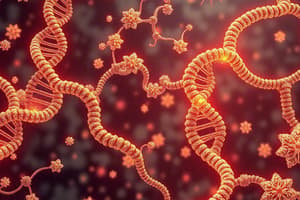Podcast
Questions and Answers
Quels sont les deux grands types d'acides nucléiques ?
Quels sont les deux grands types d'acides nucléiques ?
- Acides acétyles nucléiques
- Acides DésoxyriboNucléiques (ADN) (correct)
- Acides RiboNucléiques (ARN) (correct)
- Acides Ribonucléiques (ARN)
Où se trouve l'ADN mitochondrial ?
Où se trouve l'ADN mitochondrial ?
Dans les mitochondries
Quel type d'ARN représente 2 % des ARN totaux et donne les protéines ?
Quel type d'ARN représente 2 % des ARN totaux et donne les protéines ?
- ARN messagers (correct)
- ARN non codants
- ARN ribosomiques
- ARN de transfert
Le nucléotide est une combinaison de base azotée, ______ et phosphate(s).
Le nucléotide est une combinaison de base azotée, ______ et phosphate(s).
Les bases pyrimidiques de l'ADN sont la cytosine et la thymine.
Les bases pyrimidiques de l'ADN sont la cytosine et la thymine.
Quel est le coût énergétique de la méthylation pour une cellule ?
Quel est le coût énergétique de la méthylation pour une cellule ?
Quelle base remplace la thymine dans l'ARN ?
Quelle base remplace la thymine dans l'ARN ?
Associez les types d'ARN avec leur fonction :
Associez les types d'ARN avec leur fonction :
Flashcards
Nucleic Acids
Nucleic Acids
Fundamental molecules in life forms, with two primary types: DNA (deoxyribonucleic acid) and RNA (ribonucleic acid). DNA stores genetic information while RNA facilitates the transmission of said information.
DNA
DNA
Deoxyribonucleic acid, the molecule that carries the genetic instructions in most organisms.
RNA
RNA
Ribonucleic acid, a molecule involved in the transmission of genetic information and protein synthesis.
Nucleotide
Nucleotide
Signup and view all the flashcards
Purines
Purines
Signup and view all the flashcards
Pyrimidines
Pyrimidines
Signup and view all the flashcards
Cytosine
Cytosine
Signup and view all the flashcards
Thymine
Thymine
Signup and view all the flashcards
Uracil
Uracil
Signup and view all the flashcards
Nucleosides
Nucleosides
Signup and view all the flashcards
Study Notes
Introduction to Nucleic Acids
- Two main types of nucleic acids: Deoxyribonucleic Acid (DNA) and Ribonucleic Acid (RNA).
- DNA stores genetic information, while RNA transmits it.
- Nucleic acids are the fundamental units of complex molecules.
Nucleotides and Nucleosides
- Nucleotide = nitrogenous base + sugar (ribose or deoxyribose) + phosphate(s).
- Nucleoside = nitrogenous base + sugar.
Purines and Pyrimidines
- Nitrogenous bases are classified into purines and pyrimidines.
- Purines: Adenine (A) and Guanine (G).
- Pyrimidines: Cytosine (C), Thymine (T), and Uracil (U).
- These bases are planar due to electron delocalization within their aromatic rings.
- They absorb light at 260nm, this is used to measure Nucleic Acids.
- Proteins absorb at 280nm.
Nucleoside and Nucleotide Structure
- Details of the structure of a nucleotide are important to know.
- A diagram is essential that shows the nucleotide structure with all its components.
Bases, forms and pairings
- The forms and pairings of bases (adenine, guanine, cytosine, thymine, and uracil).
- Tautomers of these bases also exist.
- Pairing rules: A with T/U, and G with C. This is important for understanding the structure of DNA and RNA.
DNA modifications
- DNA bases can undergo modifications, methylation is one example.
- Cytosine methylation occurring at its carbon 5 is crucial.
- The process of chemical modification affects the expression of genes. Example: via methylation of cytosines in the promoters of genes.
- Other modifications like oxidative deamination also important.
Analogues of bases and their uses in therapy
- Analogues of bases such as 5-fluorouracil (5-FU) are employed in cancer treatments.
- 5-FU is an analogue of thymine in terms of structure, showing similarities in behavior in its chemical properties.
DNA History
- Key figures and milestones in DNA research (Chargaff, Watson, Crick, Franklin, Gosling, etc.)
- Key discoveries involved in determining the structure of DNA including X-ray diffraction images.
DNA types
- There are two main types of DNA: linear and circular.
- Linear DNA is within the nucleus, and plays a significant role in storing genetic information.
- Circular DNA is found in mitochondria.
DNA Structure
- DNA has a double helix structure, with two antiparallel strands.
- The two strands are held together by hydrogen bonds between complementary base pairs (A-T and G-C).
- The structure of DNA is crucial for its function in storing and replicating genetic information.
- Key dimensions (diameter, pitch, etc.) of the DNA double helix are important components of the DNA molecule.
RNA Structure and Types
- RNA is usually single-stranded, and there is variety in length, as well as structure.
- RNA comprises various types, including mRNA (messenger RNA), tRNA (transfer RNA), and rRNA (ribosomal RNA), each with specific roles.
- RNA is involved in protein synthesis and other cellular processes.
- RNA is less stable than DNA. One reason is that RNA contains ribose.
Hydrolysis of ATP
- ATP hydrolysis is important for cellular energy.
- The high-energy phosphate bonds of ATP release energy when hydrolyzed, powering many cellular processes.
RNA and Protein Synthesis
- RNA carries the genetic code from DNA and directs protein synthesis at the ribosome.
- How this process works, from the DNA sequence, to transcribed mRNA, to the ribosome, to the tRNA, to the peptide bond formation etc. are important to know.
Gene Regulation
- Controlling gene expression involves various mechanisms, including epigenetic modifications and transcriptional regulation.
Studying That Suits You
Use AI to generate personalized quizzes and flashcards to suit your learning preferences.
Related Documents
Description
Ce quiz couvre les acides nucléiques, y compris l'ADN et l'ARN, ainsi que leurs structures fondamentales. Apprenez les différences entre nucléotides et nucléosides, et explorez les bases purines et pyrimidines. Testez vos connaissances sur la structure et les fonctions essentielles des acides nucléiques.




